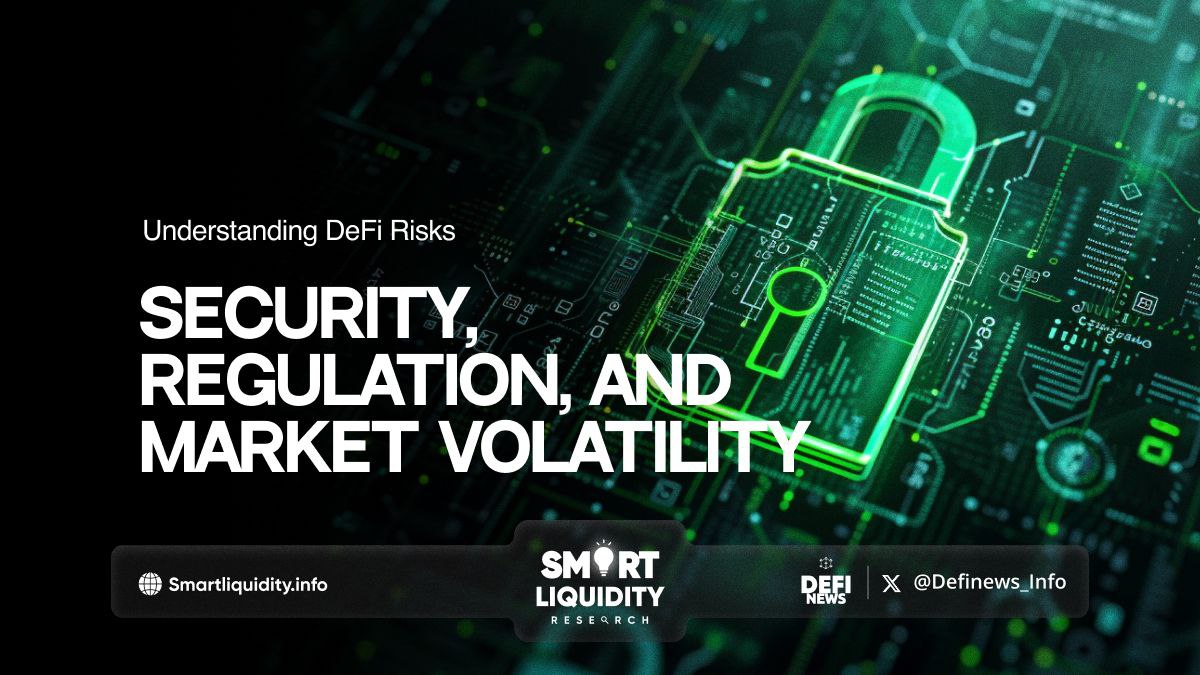Understanding DeFi Risks: Security, Regulation, and Market Volatility


Understanding DeFi Risks: Security, Regulation, and Market Volatility! Decentralized Finance (DeFi) has revolutionized the financial landscape by offering a range of financial services without relying on traditional intermediaries like banks.
While DeFi presents numerous opportunities, it also brings significant risks that users need to understand. This article explores the three primary risks associated with DeFi: security, regulation, and market volatility.
1. Security Risks
Security is one of the most critical concerns in the DeFi space. Unlike traditional finance, DeFi platforms operate on blockchain technology, which is inherently secure due to its decentralized nature. However, several security risks still exist:
- Smart Contract Vulnerabilities
DeFi protocols rely on smart contracts, which are self-executing contracts with the terms directly written into code. If there are bugs or vulnerabilities in these smart contracts, they can be exploited by malicious actors, leading to significant financial losses. High-profile hacks, such as the DAO hack in 2016 and the more recent Poly Network exploit, underscore the importance of robust smart contract auditing and security practices. - Phishing Attacks
DeFi users often manage their assets through wallets and interact with various protocols via decentralized applications (dApps). Phishing attacks, where attackers trick users into giving away their private keys or seed phrases, remain a prevalent threat. Users must exercise caution and only interact with reputable dApps and platforms. - Rug Pulls
A rug pull occurs when developers of a DeFi project abruptly withdraw all the funds from the liquidity pool and disappear. This type of exit scam is particularly prevalent in projects with anonymous or pseudonymous teams. Conducting thorough research and due diligence on project teams can mitigate the risk of rug pulls.
2. Regulatory Risks
The regulatory landscape for DeFi is still evolving, creating uncertainty for both developers and users. Key regulatory risks include:
- Lack of Clarity
Many jurisdictions have not yet established clear regulations for DeFi activities. This lack of clarity can create legal uncertainties for DeFi projects and users. Regulatory developments, such as the U.S. Securities and Exchange Commission (SEC) scrutinizing DeFi protocols, can impact the legality and accessibility of certain services. - Compliance Challenges
DeFi platforms often operate globally, making it challenging to comply with the regulatory requirements of multiple jurisdictions. Issues such as Know Your Customer (KYC) and Anti-Money Laundering (AML) compliance are particularly complex in a decentralized environment. - Potential for Regulatory Crackdowns
In response to concerns about financial stability, consumer protection, and illicit activities, regulators may take stringent actions against DeFi platforms. This could include imposing restrictions, fines, or even shutting down non-compliant projects. Users should stay informed about regulatory developments in their respective regions.
3. Market Volatility
Market volatility is an inherent risk in the cryptocurrency space, and DeFi is no exception. Key factors contributing to market volatility include:
- Price Fluctuations
The value of cryptocurrencies and DeFi tokens can be highly volatile. Sudden price swings can lead to significant gains or losses for users. Leveraged trading and yield farming can amplify these effects, making it essential for users to understand the risks involved in these activities. - Liquidity Risks
DeFi relies heavily on liquidity provided by users. In market stress, liquidity can dry up, leading to slippage and difficulties in executing trades. This can result in substantial losses, particularly for users engaged in high-frequency trading or large transactions. - Economic Factors
Broader economic trends and sentiments can influence the DeFi market. Regulatory news, macroeconomic events, and technological advancements can all impact the value and stability of DeFi assets. Diversifying investments and adopting risk management strategies can help mitigate the effects of market volatility.
Mitigating DeFi Risks
While the risks associated with DeFi are significant, there are steps users can take to protect themselves:
- Conduct Thorough Research
Conduct thorough research Before investing in any DeFi project. Understand the project’s team, technology, and use case. Look for audits and reviews from reputable sources. - Use Reputable Platforms
Stick to well-known and reputable DeFi platforms and dApps. Avoid projects with anonymous teams or unclear value propositions. - Diversify Investments
Spread investments across multiple projects and asset classes to reduce exposure to any single point of failure. - Stay Informed
Keep up with the latest developments in the DeFi space, including security updates, regulatory changes, and market trends. - Use Security Best Practices
Safeguard private keys and seed phrases. Use hardware wallets for added security and enable two-factor authentication where possible.
In Summary
DeFi offers a promising alternative to traditional financial systems, but it is not without risks. Understanding and mitigating the security, regulatory, and market volatility risks is crucial for anyone looking to participate in the DeFi ecosystem. By staying informed and adopting best practices, users can navigate the DeFi landscape more safely and effectively.




